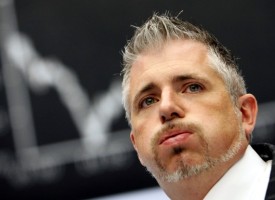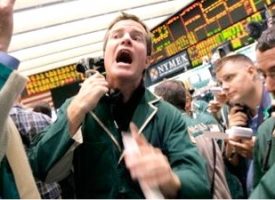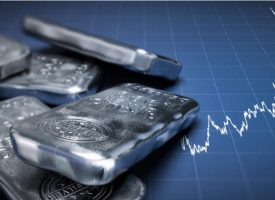Today King World News is featuring a piece by a man whose recently released masterpiece has been praised around the world, and also recognized as some of the most unique work in the gold market. Below is the latest exclusive KWN piece by Ronald-Peter Stoeferle of Incrementum AG out of Liechtenstein.
By Ronald-Peter Stoeferle, Incrementum AG Liechtenstein
October 29 (King World News) – The Monetary “Waiting For Godot”
Massive Inflation Has Been Caused By The Fed’s ZIRP… maybe not yet in standard CPI or PCE measurement terms – but while market participants are not paying any more monetary interest to the Fed, the interest being paid for their financial policy decisions has exploded over the last years. During the press conferences of the recent FOMC meetings, millions of well-educated investment professionals will have been sitting in front of their screens, chewing their fingernails, listening as if spellbound to what Janet Yellen has to tell them. Will she finally raise the federal funds rate that has been zero bound for over six years?
Obviously, each decision is accompanied by nervousness on the markets. Investors are fixated by a fidgety curiosity ahead of each Fed decision and fail to meticulously observe Janet Yellen and the FOMC and engage in monetary ornithology on doves (growth- and employment-oriented FOMC members) and hawks (inflation-oriented FOMC members); they also hope for some enlightening information from Ben Bernanke. According to Reuters, some market participants paid some $250,000 just to join one of several dinners, where the ex-chairman spilled the beans.
Apparently, he does not expect the federal funds rate to return to its long-term average of about 4% during his lifetime. In a conversation, Bernanke stated that a rate hike would only be possible in an environment in which “the U.S. economy is growing strongly enough to bear the costs of higher rates”. Moreover, a rate increase would have to be clearly communicated and anticipated by the markets – not to protect individual investors from losses, but rather to prevent jeopardizing the stability of the “system as a whole”.
It is on the one hand axiomatic that ZIRP cannot be a permanent fixture. Furthermore, Janet Yellen has been tweeting on about increasing rates for almost two years now. How much more lead time will it require to prepare the markets? In September, she once again chickened out, even though we are not talking about hiking the rate back to “monetary normalcy” in one blow. The decision on the table is whether or not to increase the rate by a trifling quarter point! It simply about a smooth beginning of a long drawn out and cautiously managed tightening process.
The Fed’s quandary can be understood a little better by examining what “monetary normalcy”, or a “normal interest rate”, is supposed to be. Or even more fundamentally: what is an interest rate? We “Austrians” understand an interest rate as an expression of market participants’ time preference. The underlying assumption is that people are inclined to consume a certain product sooner rather than later. Hence, if savers restrict their current consumption and provide the resources for investment instead, they do so only on condition that they will be compensated by increased consumptive opportunities in the future.
In free markets, the interest rate can be regarded as a measure of the compensation payment, where people are willing to trade present goods for future goods. Such an interest rate is commonly referred to as the “natural interest rate”. Consequently, the FOMC bureaucrats would ideally specify a “normal interest rate” that equals the “natural” one. This is, however, not very likely for the same reason that all forms of central planning and price dictation have to fail: a lack of knowledge on the part of the planners!
When resources are invested, this implies that they are tied in an irreversible process to a very concrete form and function. Since this is happening in all nooks and crannies of an economy where individuals detect potential for profit by means of their specific knowledge, capital should be understood as a heterogeneous structure resulting from evolutionary dynamics. Under free market conditions with a corresponding natural interest rate, this capital structure would be tailored according to the preferences of the people.
If the most important price in an economy, namely the price of credit, is subject to manipulation, this causes serious distortions in the capital structure. In the event of a liquidity crisis, artificially low interest rates may temporarily have a positive effect by fostering lending and hence compensating for excessive skepticism amongst market participants. As a permanent means, however, it triggers malinvestments, i.e. investments that would be unprofitable under normal conditions – hence, there is an increase in total investment and, at the same time, an incentive to consume more and save less.
How is this possible? How can more investment projects be launched while the pool of resources at the same time is in decline? It is only seemingly possible, as in a fiat money system credit can be generated ex nihilio. The lower the interest rate, the more the markets are flooded with credit.
ZIRP was introduced six years ago in response to the financial crisis, and three QE programs have been conducted. This so-called “unconventional monetary policy” is supposed to be abandoned as soon as the economy has gathered pace. Despite the tremendous magnitude of these market interventions, the momentum in the US economy is rather lame. Weak Q1 data, which probably resulted from a weak trade balance due to a 15% rise of the USD, shocked even the most pessimistic of analysts; the OECD and the IMF have revised down their 2015 growth estimates. A long-lasting, self-sustaining growth is out of the question. This confirms the assumption that ZIRP fuels everything under the sun (see The Unseen Consequences of Zero-Interest-Rate Policy) but long-term productive investment.
And what about unemployment and inflation that are key elements of the Fed’s mandate? The conventional unemployment rate (U3) has returned to its long-run normal level, so the view prevails that things are developing well. However, those figures conceal a participation rate that has fallen by more than 3% since 2008, indicating that some 2.5 million Americans are currently no longer actively looking for a new job. However, should the economic situation improve, they would likely rejoin the labor force. Furthermore, the proportion of those only working part-time due to a lack of full-time positions is much higher now than before the crisis. “True” unemployment currently stands rather at about 7,25%.1
With regard to inflation, the Fed’s target is 2%, as measured by growth of the PCE-index. This aims to buffer the fiat money system against the threat of deflation, i.e. against sinking prices, as in such an environment the debt-servicing capacity of market participants (e.g. governments, private enterprises, financial institutions, private households) would come under intense pressure and likely trigger a chain reaction in which loans collapse and the monetary system implodes. However, in many countries, and among them the USA, inflation is remarkably low – partly due to transitory effects of lower energy and import prices –, while low interest rates have merely weaved their way to asset price inflation so far. As price reactions to monetary policy maneuvers may occur with a lag of a few years, we should expect that sooner or later inflation will also spill over to normal markets.
Whereas as a response to the development of economic and employment data an intrepid rate hike is scarcely likely, an inflation-induced rate hike could occur anytime. Considering the current composition of the FOMC, which is extremely dovish – implying inflation-sensitive voices are relatively underrepresented – gives rise to the suspicion that this is not very likely the scenario in the short term. One is concerned about the economic development, which has a shaky foundation and headwinds from other parts of the world: it appears that growth has cooled down sustainably in the BRICS countries – China might be on the brink of a severe recession. (Indeed, China was possibly the most decisive factor to nudge the Fed away from raising rates in September.) This implies that world- wide interest rates will remain at very low levels and a significant rate hike in the USA would represent a sharp deviation in this environment, entraining massive competitive disadvantages.
The markets are noticeably pricing out a significant rate hike. Rate cuts are one-way streets, the production structure has long since adapted to ZIRP and “short-term gambling, punting on momentum-driven moves, on levered buybacks” are further lifting the opportunity costs of abandoning it. In order to try to rescue its credibility, the Fed may decide to try some timid, quarter- point alibi increases. But what will they do if markets really crash? Indeed, they are terrified of the avalanche that they might trigger! If there are be any symptoms that portend calamity, the Fed will inevitably return to ZIRP, launch a QE4, or might even introduce negative interest rates. Hence, there does not seem to be a considerable degree of latitude such that a return to conventional monetary policy could seriously be expected.
“The Fed is raising the rates!” – This has become a running gag.
1 Conceptual Pitfalls and Monetary Policy Errors, Andrew T. Levin
***ALSO JUST RELEASED: Bill Fleckenstein On The Fed’s Propaganda And How It Impacted Markets, Plus A Bonus Q&A CLICK HERE.
© 2015 by King World News®. All Rights Reserved. This material may not be published, broadcast, rewritten, or redistributed. However, linking directly to the articles is permitted and encouraged.









